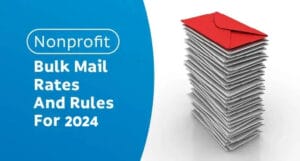Ask Effectively for a Donation in a Direct Mail Letter
It can be hard to ask for a donation, but fundraising is one of the most important parts of a successful campaign. If you want to win an election, you need a solid budget to pay for TV ads, signs, direct mail, and other marketing approaches. Fundraising allows you to raise the money you need to get your name out there.
Unfortunately, separating people from their hard-earned money isn’t easy. Direct Mail Fundraising can be a great way to personally reach out to potential contributors. However, not all donation letters are created equal. If you want any chance of receiving donations, you’re going to have to do some convincing.
Below you will find some things to keep in mind when you have to ask for a donation in a direct mail letter. By following these tips, you can increase your chances of successfully funding your campaign.
1. Cold or Warm Leads?
Before you even begin crafting your direct mail letter, you will need people to send them to. This will often include party supporters, local businesses, and even individuals. However, not every lead offers the same potential for a response. Picking your audience can help to increase your response rate and save marketing dollars on mailing unlikely donators.
A warm lead is a person who has a suspected interest in your campaign. They may be a party supporter in the past, a voter who participates in every election, or someone who visited an event to learn more. Politics is not something that everyone is interested in, and with information that shows that these targets have been involved makes them more likely to contribute.
A cold lead is someone who has not shown interest in the past. When you send out a mass direct mail, you are likely to run into many cold leads. These people likely aren’t aware of your campaign, making them a much harder sell. In your letter, you will have to catch them right from the start if you want to avoid ending up in the trash.
2. Catch the Eye
As is true with any piece of mail, it is important to get your letter read. This starts with the envelope, which is the first thing that people will see from your direct mail letter. In a sea of white envelopes from bills and other negative mail, your mail piece should be a beacon of hope. By choosing a colored envelope, you are helping your letter stick out from the second they reach into the mailbox until they sort through their mail.
3. Personalize It
No matter the situation, a personal touch always helps. This is especially true when you are asking for someone’s money! Personalization can go a long way towards making something look professional and important, and is relatively easy to do.
Rather than laser printing your mail, handwriting the name and address add a touch of personality and importance to the piece. You can also apply a stamp to each piece to add to the hand-crafted authenticity. This way it makes the mail seem like a letter from an old friend and helps to build a connection with the reader. Finally, hand-signing your letter tells the reader that they are important to you and not just another target.
4. Be Clear and Concise
When trying to convince someone to read your letter, readability plays a huge role. Nobody wants to read an essay or a wall of text. Keep in mind that you don’t have long – the average attention span for direct mail is about 5-8 seconds. You want to make the most of that time by making the text take less time to read.
It is best to format your letter with short sentences, multiple paragraphs, bullet points, subheadings, and simple verbiage. This makes your mail less fatiguing to read. You should also only include important information and do not stray too much from the core points to ensure your letter is clear to its purpose.
5. Introduce Yourself
When your reader opens the letter, you only have a few seconds to grab their interest. This is where the introduction comes in. In your header, you will want your name in large text or even as a logo. You can also include a headshot. This gives a name and face to the reader, which makes your introduction more personal. You will also want to tailor your letter to either a warm or cold lead, as they require different levels of convincing and involve a different greeting.
In this introduction, you will want to establish your credibility by explaining who you are and what you are doing. You will want to let them know your background, not your entire bio, just the most relevant details, and how they relate to your campaign. Be sure to make your cause clear right away. Let them know that you’re seeking their financial support for your campaign and that you cannot do it without them. You can also include your goal or suggested donation amount here. The more it is mentioned the more likely you are to receive it. By sharing your goal and the benefits their donation will have, you can elicit good feelings and inspire them to give more in the future.
Read Also Political Mail: Your Hidden Ace Card
6. Ask for a Specific Donation
If someone came up to you on the street and asked for $5, would your first thought be to hand them a $20 bill? When fundraising, you want to ask for a specific amount of money. This amount should also be higher than you would accept because then there is room to “haggle”.
By asking for a specific amount, you take the work of deciding on an amount away from the contributor. They do not have to think of what is too high or too low, and can instead simply decide if they can contribute that amount. Additionally, if you ask for $50, you will most likely not receive more than $50. However, if you ask for $100, you can get $50, $75, or even $100.
7. Explain What the Money Is Used For
When people are sending you money, they want to know what it’s going towards. Sure, your political campaign is a good enough answer, but being able to go into specifics makes it seem like less of a cash-grab and more like a contribution to progress. In your letter, explain what you plan to do with any funds raised and how it contributes to your campaign. For example, you could let the reader know that by donating, they are contributing to improving the educational system (or any other hot-button issue) by helping get you elected.
8. Make Donating Easy
Even if you convince the reader to donate, you still have to collect the money! Thankfully, with the advancement of technology, this has become even easier in the past years. You will want to make the donation as simple as possible so that they can justify the effort to send you the money.
A return envelope is an important part of your letter. It gives the contributor the option of a check or write-in charge on their debit or credit card. By attaching a check or writing their information down, you can collect the money easily. Alternatively, a website with a donation portal through a host like PayPal can make receiving donations even easier. This would require just a few clicks, and also can direct the reader to your website to learn more while they’re there. What’s even better is that you can personalize the URL they visit to include their information and a unique thank you.
Now that you have the tools for crafting a direct mail letter that will help you collect donations, you can begin fundraising for your campaign. Be sure to keep the tips in mind so that you can reach your goals, build your campaign, get elected, and make some change!




